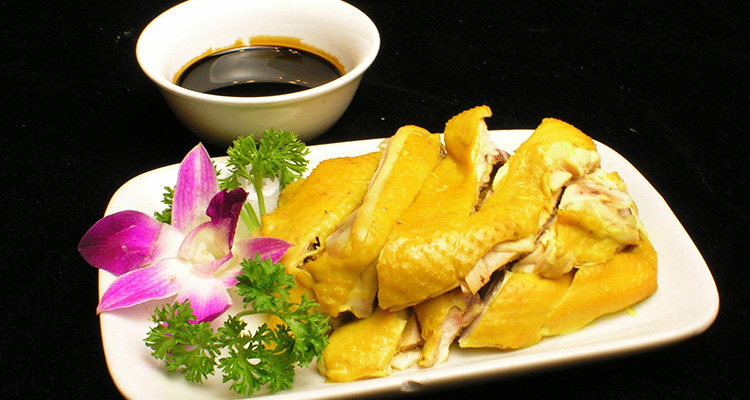White Cut Chicken: The Art of Pure Flavor on Lingnan Tables
In the broad canvas of Chinese cuisine, if Sichuan food is bold and spicy, Cantonese cooking is watercolor—delicate, refined, and driven by the ingredient’s natural taste. White cut chicken (白切鸡) is the finishing stroke of that painting: a simple-looking but deeply expressive dish served across southern China, especially Guangdong, Guangxi and Hainan. Rather than masking flavors with heavy sauces, it celebrates the chicken’s own sweetness and texture. For curious travelers, one bite of authentic white cut chicken unlocks Cantonese culinary philosophy.
Origins and Cultural Meaning: From Home Table to Festival Centerpiece
Although exact records are scarce, white cut chicken has long roots in Lingnan poultry farming and family kitchens. Breeds such as Qingyuan (清远鸡) from Guangdong and Wenchang (文昌鸡) from Hainan are prized for making the dish. Historically, simple poaching showcased the freshness of the bird before modern refrigeration.
In Cantonese-speaking areas, the saying “no feast without chicken” reflects the bird’s symbolism: “chicken” (鸡) sounds like “good luck” (吉). A glossy plate of white cut chicken appears on New Year’s Eve dinners, wedding banquets and when hosting honored guests. Serving it signals respect and wishes for prosperity—so you’re tasting tradition as well as food.

Ingredients and Technique: Minimalist Cooking, Maximum Precision
The simplicity of white cut chicken hides strict demands: top-quality poultry and exact temperature control.
- Best choice: a young, non-egg-laying hen often called a “young hen” or “tongzi ji” (童子鸡), around 1.5–2.5 kg. These birds have balanced fat and tender fibers.
- Famous varieties: Qingyuan chicken and Wenchang chicken are regional stars.
Traditional preparation centers on “immersion-poaching.” Heat water to just below boiling (about 85–95°C). Repeatedly lower and lift the whole bird three to four times so the skin tightens evenly, then simmer gently for roughly 20–30 minutes depending on size. Immediately plunge the bird into ice water—the sudden chill firms the skin, creates a thin layer of jelly between skin and meat, and preserves juiciness. The ideal result: tender, moist meat with springy, non-greasy skin and faintly pink bone marrow that proves perfect timing, not undercooking.

Flavor Profile and the Soulful Dipping Sauce
A plated white cut chicken is visually restrained yet elegant: glossy golden skin and pale, tender flesh. Texturally it’s layered—skin is smooth and slightly chewy, meat is firm but succulent, and the aroma is clean and chicken-forward.
The real highlight is the dipping sauce. The classic ginger-scallion sauce (姜葱酱) is simply freshly minced ginger, chopped scallions, a pinch of salt, and hot oil poured over to release aroma—sometimes mixed with a little rendered chicken oil. The sizzle of hot oil transforms the ingredients, and the piquant, aromatic sauce lifts the chicken from humble to sublime. Regional alternatives include ground sand-ginger (sha jiang) sauce or light soy-based sauces.
How to Taste Like a Local
White cut chicken is often chopped into neat pieces and presented back on the carcass. Try these steps:
- First bite: taste plain to appreciate natural chicken sweetness.
- Second bite: dip in ginger-scallion sauce to savor contrast and added depth.
- Where to go: Don’t limit yourself to upscale restaurants—well-liked dai pai dong (street stalls) and time-honored roast shops often serve outstanding versions. Look for busy spots and glossy, intact chicken skin in display windows.
- Best pairing: steamed fragrant rice cooked in chicken broth, a plate of crisp blanched greens, and a bowl of slow-simmered Cantonese soup make a complete meal.
- Don’t be alarmed by pale pink near the bone—it indicates perfectly timed poaching, not rawness.
A basic home method for travelers to try:
- Choose a 1.5–2 kg quality chicken (a young hen or “three-yellow chicken”).
- Bring a large pot of water to a boil with a few slices of ginger and a knot of scallion. Dip the chicken head-first into hot water for 8–10 seconds, lift; repeat three times.
- Lower heat so water barely simmers; cover and poach the whole chicken 25–30 minutes (adjust by size).
- Test doneness by piercing the thickest thigh—clear juices mean done.
- Immediately transfer to ice water for 10–15 minutes. Drain, brush lightly with sesame oil, then chop.
- Sauce: mix minced ginger, chopped scallions and salt; pour 1–2 tablespoons of smoking-hot oil over, stir, and serve.

Conclusion
White cut chicken is far from bland—it’s a deliberate celebration of freshness and technique that defines Cantonese cooking. When you travel through southern China, make time to try a plate: it’s an ideal way to taste local history, hospitality, and culinary philosophy in one memorable mouthful.


